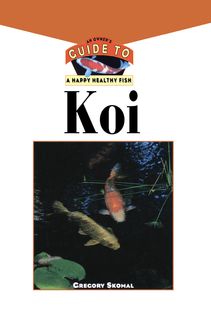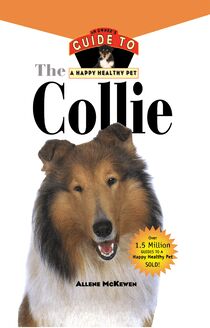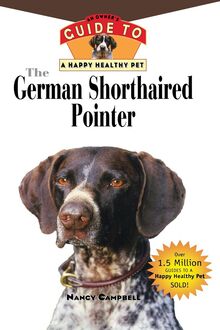The German Shorthaired Pointer , livre ebook
94
pages
English
Ebooks
2008
Vous pourrez modifier la taille du texte de cet ouvrage
Obtenez un accès à la bibliothèque pour le consulter en ligne En savoir plus
Découvre YouScribe en t'inscrivant gratuitement
Découvre YouScribe en t'inscrivant gratuitement
94
pages
English
Ebooks
2008
Vous pourrez modifier la taille du texte de cet ouvrage
Obtenez un accès à la bibliothèque pour le consulter en ligne En savoir plus
Publié par
Date de parution
21 avril 2008
Nombre de lectures
3
EAN13
9780470335246
Langue
English
Poids de l'ouvrage
1 Mo
PART ONE: Welcome to the World of the German Shorthaired Pointer.
1. What Is a German Shorthaired Pointer?
2. The German Shorthaired Pointer's Ancestry.
3. The World According to the German Shorthaired Pointer.
PART TWO: Living with a German Shorthaired Pointer.
4. Bringing Your German Shorthaired Pointer Home.
5. Feeding Your German Shorthaired Pointer.
6. Grooming Your German Shorthaired Pointer.
7. Keeping Your German Shorthaired Pointer Healthy.
PART THREE: Enjoying Your Dog.
8. Basic Training (Ian Dunbar, Ph.D., MRCVS).
9. Getting Active with Your Dog (Bardi McLennan).
10. Your Dog and Your Family (Bardi McLennan).
11. Your Dog and Your Community (Bardi McLennan).
PART FOUR: Beyond the Basics.
12. Recommended Reading.
13. Resources.
Publié par
Date de parution
21 avril 2008
Nombre de lectures
3
EAN13
9780470335246
Langue
English
Poids de l'ouvrage
1 Mo
Howell Book House
An Imprint of Macmillan General Reference USA
A Pearson Education Macmillan Company
1633 Broadway
New York, NY 10019-6785
Macmillan Publishing books may be purchased for business or sales promotional use. For information please write: Special Markets Department, Macmillan Publishing USA, 1633 Broadway, New York, NY 10019-6785.
Copyright 1999 by Howell Book House
Copyright all photography by Mary Bloom unless otherwise noted.
All rights reserved. No part of this book may be reproduced or transmitted in any form or by any means, electronic or mechanical, including photocopying, recording, or by an information storage and retrieval system, without permission in writing from the Publisher.
MACMILLAN is a registered trademark of Pearson Education
Library of Congress Cataloging-in-Publication Data
Campbell, Nancy (Nancy C.)
The German shorthaired pointer : an owner s guide to a happy healthy pet / Nancy Campbell
p. cm.
Includes bibliographical references.
ISBN 978-0-470-33524-6
1. German shorthaired pointer.
SF429.G4C25 1999 99-14625
636.752 5-dc21 CIP
Manufactured in the United States of America
10 9 8 7 6 5 4 3 2
Series Director: Amanda Pisani
Book Design: Michele Laseau
Cover Design: Iris Jeromnimon
Illustration: Patricia Douglas
Photography: All photography by Mary Bloom unless otherwise noted.
Nancy Campbell: 17, 23, 43, 82, 84, 88, 91, 93, 94
Ann Carter: 38-39
Howell Book House: 22
Dr. James Moore: 77
Production Team: Carrie Allen, Oliver Jackson, Clint Lahnen, Christina Van Camp,
Dennis Sheehan, Terri Sheehan
Contents
part one
Welcome to the World of the German Shorthaired Pointer
1 What Is a German Shorthaired Pointer?
2 The German Shorthaired Pointer s Ancestry
3 The World According to the German Shorthaired Pointer
part two
Living with a German Shorthaired Pointer
4 Bringing Your German Shorthaired Pointer Home
5 Feeding Your German Shorthaired Pointer
6 Grooming Your German Shorthaired Pointer
7 Keeping Your German Shorthaired Pointer Healthy
part three
Enjoying Your Dog
8 Basic Training
by Ian Dunbar, Ph.D., MRCVS
9 Getting Active with Your Dog
by Bardi McLennan
10 Your Dog and Your Family
by Bardi McLennan
11 Your Dog and Your Community
by Bardi McLennan
part four
Beyond the Basics
12 Recommended Reading
13 Resources
part one
External Features of the German Shorthaired Pointer
chapter 1
What Is a German Shorthaired Pointer?
There is no faith which has never yet been broken, except that of a truly faithful dog.
-Konrad Z. Lorenz.
A German Shorthaired Pointer, whether puppy or adult, is a regal comic. It is a close working, multiple purpose hunting dog with boundless energy, love of purpose and dedicated trainability. From the country of origin comes this standard description: a harmonious dog, whose proportions give a guarantee of endurance, power and speed. Its characteristic features are a noble appearance, graceful outlines, a clean-cut head, a well carried tail and a taut, gleaming coat. In Germany, the Shorthair, as we will call the breed throughout this book, is not only an upland hunter used for finding and pointing birds, but also for trailing furred game and retrieving out of water.
From origins in the nineteenth century until today, however, the Shorthair has found many uses, from hunting birds and other game to tracking, obedience and agility competition, bomb and drug detection and dog sled racing. Shorthairs have been successful assistants to the hearing- and sight-impaired and wheelchair bound, and make cheerful therapy dogs as visitors to hospitals and senior residences.
Whatever the Shorthair trains to do, it does the job with enthusiasm, energy, devotion, dedication and good humor. It is this very energy and positive nature that makes a German Shorthaired Pointer a good choice for an active family willing to devote time and training to a dog. Shorthairs enjoy endless games of ball, fetch and Frisbee with kids or adults, and bond to the family readily. In fact, they do not like to be without their people and are never more joyful than when greeting a homecoming owner.
They make fine running, hiking and biking companions, generally enjoy lifelong good health and most love to ride in the car and swim. Although I have owned many breeds of dogs over the past half century, I have been a devoted German Shorthaired Pointer owner and rescue volunteer for the past twenty-five years. Once you belong to a Shorthair, if it is the right dog for you, you will surely own more than one in your lifetime. I have owned more than a dozen Shorthairs and lived with many a rescue foster dog during the time I have been blessed to know the breed. Each was different, each unique, but each shared the comedic energy of a true German Shorthaired Pointer.
The Breed Standard
The standard for any breed exists to describe characteristics that are the ideal portrayal of a dog that is typical of its breed. To be a good representative of that breed, a dog should have the characteristics outlined in the standard. This is a description that has been developed by the first founders of the breed. These people combined other purebreds over a period of time to get the German Shorthaired Pointer. When they had what they thought looked, acted and worked like the dog they were trying to create, they wrote a breed standard. After a number of generations, the breed is finally considered pure. At various points throughout the history of the breed, the standard may have been modified to refine the description or clarify breed characteristics. This is an ongoing process. The parent club membership of any breed can vote to modify the breed standard periodically.
The parent club of each breed submits the standard to the American Kennel Club (AKC), and the standard becomes the official AKC standard until the national breed club chooses to alter it. It is important to note that the American Kennel Club is only a registry of purebred dogs in this country. The American Kennel Club also creates a forum for conformation and performance events in the United States. Registry with the AKC is not the equivalent of any breed s stamp of approval. Registry with the AKC merely means the dog has, according to the breeder, a father and mother registered as purebred dogs of the same breed with the AKC. Just because a Shorthair is registered with the AKC does not mean it is a good or healthy example of the breed. To get a good dog of any kind, you must first find a good breeder.
The Shorthair is an aristocratic, well-balanced dog .
You can get a complete copy of the breed standard from the AKC or from the national breed club, and the AKC library can tell you who to call in the parent club for that mailing. If you have Internet access, you can read both the American and international breed standards by going to the GSPCA (German Shorthaired Pointer Club of America) Web site through any Internet search engine.
The overall look of a Shorthair true to type is of an aristocratic, athletic composition with no one part out of balance with any other. The dog should look balanced and composed from nose to tail. It is a strong, muscular, active, alert and eager breed, capable of endurance and high performance. It is a hunting dog first, and has an expression of intelligent humor and willingness to please and work for its owner. A Shorthair s high energy should not be mistaken for nervous hyperactivity, and its expression should be of good-natured intensity. Aimless hyperactivity is a fault in any breed.
Once you have read the approved breed standard, you may be able to picture what a good German Shorthaired Pointer looks like, but you will want to visit breeders, conformation shows and field and performance events with this standard in mind to become clearer about variations within the breed. There is quite a lot of difference in size, color and general appearance.
Excerpts from the American Breed Standard follow in italic type: The overall picture which is created in the observer s eye is that of an aristocratic, well-balanced, symmetrical animal with conformation indicating power, endurance and agility and a look of intelligence and animation. The dog is neither unduly small nor conspicuously large. It gives the impression of medium size, but is like the proper hunter (reference is to a horse hunting with pack hounds) with a short back, but standing over plenty of ground. Tall and leggy dogs, or dogs which are ponderous or unbalanced because of excess substance should be definitely rejected. The first impression is that of a keen enthusiasm for work without indication of nervous or flighty character. Movements are alertly coordinated without wasted motion. Grace of outline, clean-cut head, sloping shoulders, deep chest, powerful back, strong quarters, good bone composition, adequate muscle, well-carried tail and taut coat, all combine to produce a look of nobility and indicate a heritage of purposefully conducted breeding. A judge must excuse a dog from the ring if it displays extreme shyness or viciousness towards its handler or the judge. Aggressiveness or belligerence toward another dog is not to be considered viciousness .
Faults: Doggy bitches and bitchy dogs are to be faulted .
German, American and international Standards all describe the Shorthair as noble looking, having a graceful outline, a tight coat and confident body and tail carriage. These characteristics speak as much about sound temperament as beauty of form. A nervous, shy or hyperactive dog is faulty. A Shorthair can only be powerful if it is well muscled and fit, so a dog that is fat or lacking bone does not fall within the ideals set by the standard.
The Shorthair is of medium size. Males (left) are expected to be slightly taller and heavier than females (right) .
Size
Medium size is also prescribed for this breed. The standard actually call







